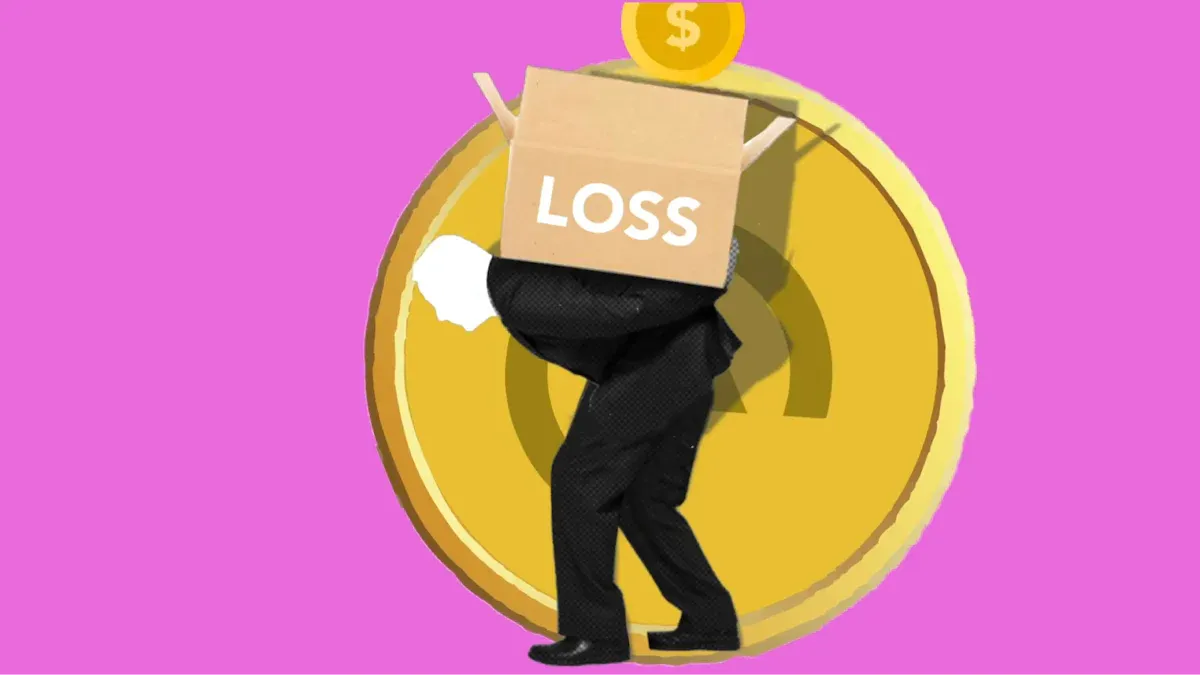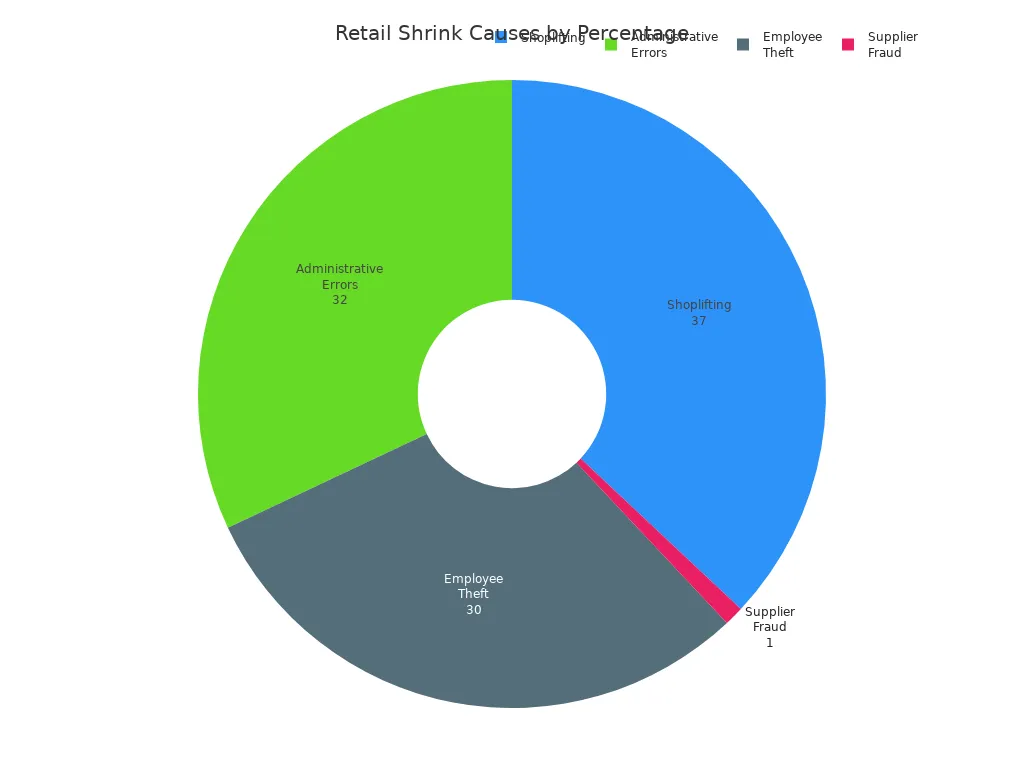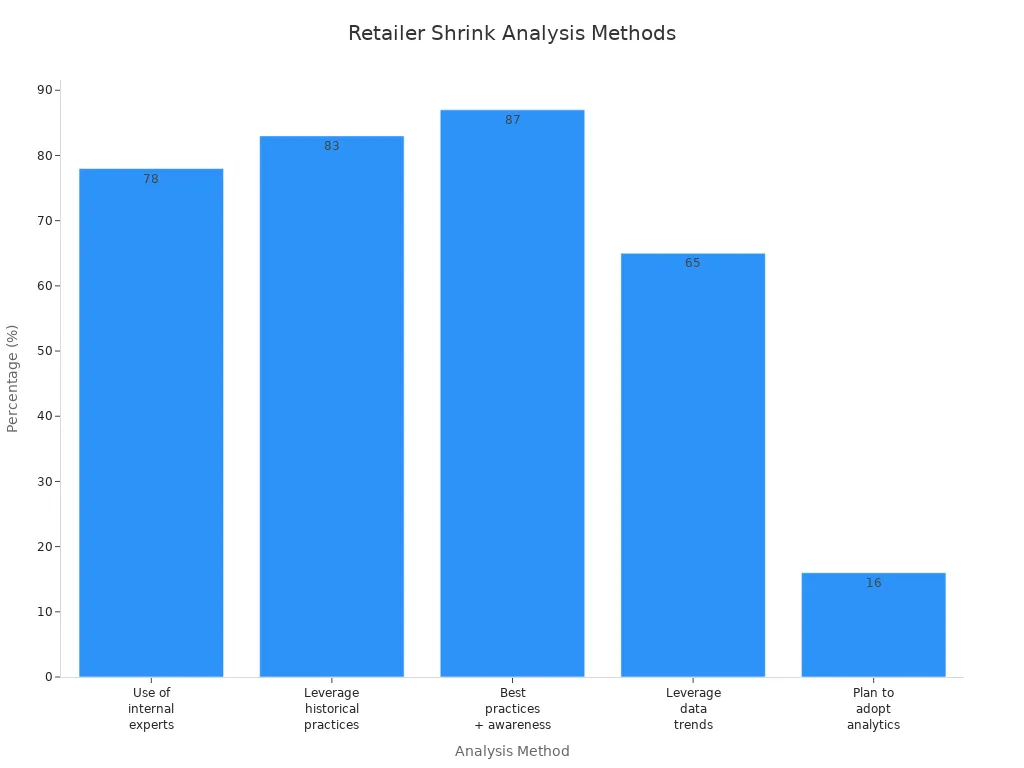Retail Shrink: Understanding, Measuring, and Preventing Inventory Loss

Retail shrink means the difference between the amount of inventory you expect and what you actually have. Retail shrinkage happens when products disappear from shelves because of theft, errors, or damage. You face serious challenges when shrink affects your store. Shrink can reduce your retail profitability and limit growth. Many retailers lose about 6% of annual revenue because of shrink. Retail shrink rates rose to 1.6% in 2022, and global retail shrink could cause $132 billion in loss by 2024. You need to understand shrink to protect your profitability and stop inventory loss. Measuring retail shrink helps you find problems early. Preventing shrink saves money and keeps your retail business strong.
Retail shrink rates increased to 1.6% in 2022.
Retailers may lose up to $132 billion globally by 2024.
Shrink causes nearly 6% annual revenue loss for retailers.
Key Takeaways
Retail shrinkage is the gap between expected and actual inventory, often caused by theft, errors, or damage.
Shoplifting accounts for 37% of retail shrink, making it crucial to implement strong security measures.
Regular inventory audits help identify shrink early, allowing for timely corrective actions.
Employee training is essential; a well-informed staff can effectively prevent shrink and protect profits.
Using technology like video surveillance and inventory management systems can significantly reduce shrinkage.
What Is Retail Shrink?

Retail Shrinkage Defined
You face retail shrinkage when you lose products between buying them from your supplier and selling them to your customers. Retail shrinkage is the difference between your recorded inventory and your actual inventory. This loss can happen for many reasons, such as theft, mistakes, or damage. In the retail industry, shrinkage is a measurement of inventory loss as a percentage of sales during a set period. You use the formula: Inventory Shrinkage = Recorded Inventory - Actual Inventory. Shrinkage can come from theft, fraud, or human error. You need to track shrinkage because it affects your store’s success.
Concept | Definition |
|---|---|
Retail Shrink | A measurement of inventory loss as a percentage of sales during a specific inventory period, including losses from theft, administrative errors, and other factors. |
Inventory Loss | Encompasses a broader range of issues, including supply chain losses and ecommerce fraud, which may not be reflected in shrink calculations. |
Shrink is often a trailing indicator of inventory loss. You may notice shrinkage after the loss has already happened.
Why Inventory Loss Matters
Retail shrinkage can hurt your profits. When you lose inventory, you lose money. The National Retail Federation reported that shrinkage reached over $94 billion in 2021. Shrinkage includes damage, mistakes, and theft. If you have too much inventory, you may need to mark down prices or throw away unsold goods. This reduces your profit margins. If you have too little inventory, you miss sales and disappoint customers. Out-of-stock items cost U.S. retailers about $82 billion each year. Shrinkage can also damage your brand’s reputation and make customers less loyal.
Inventory shrinkage affects your bottom line.
Shrinkage can lead to lost sales and higher costs.
You need to control shrink to protect your retail business.
Main Causes of Shrink
You should know the main causes of retail shrinkage. Shoplifting is the biggest cause, making up 37% of shrinkage. Employee theft comes next at 30%. Administrative errors, such as mistakes in paperwork or counting, cause 32%. Supplier fraud is less common but still a risk.

Shoplifting: 37%
Employee theft: 30%
Administrative errors: 32%
Supplier fraud: 1%
You need to watch for all these causes. Shrinkage can happen in many ways, so you must stay alert. By understanding retail shrinkage, you can take steps to reduce loss and keep your inventory safe.
Impact of Retail Shrinkage
Financial Effects on Retailers
You feel the impact of retail shrinkage every time you check your store’s numbers. Shrink takes away your profit and makes it harder to grow your business. In 2021, shrink accounted for 1.6% of retail sales, which led to about $94.5 billion in loss. When you lose inventory, your gross margin drops. This means you have less profit to invest in new products or store improvements. You may also face tighter budgets, which can slow down your plans for innovation and growth.
Shrink reduces your profit and affects your bottom line.
Loss from theft and fraud makes it harder to reach your profit goals.
Total retail loss can force you to cut spending on important projects.
James Kehoe, CFO at Walgreens, has often emphasized that reducing shrinkage is crucial for retail profitability.
You need to watch your numbers closely. Shrink can quickly add up and hurt your total retail loss figures. If you do not control shrinkage, you risk losing your competitive edge.
Operational and Customer Impact
Shrinkage does not just affect your profit. It also changes how you run your store and serve your customers. You must set up checks and balances with vendors and suppliers. You need to spend more on security and loss prevention. This means you have to use your resources wisely.
Challenge | Description |
|---|---|
Efficiency Loss | Retail shrinkage leads to inefficiencies in inventory management and operational processes. |
Profitability Impact | Shrinkage directly affects the bottom line, reducing overall profitability for retailers. |
Increased Security Costs | Retailers must invest in enhanced security measures, increasing operational costs. |
Employee Training Requirements | Ongoing training for staff is necessary to combat shrinkage, requiring time and resources. |
Need for Advanced Technology | Implementation of advanced inventory management systems is essential to track and reduce shrinkage. |
You may need to train your employees more often. You might also invest in new technology to track shrink. Shrink can lead to empty shelves, which disappoints your customers. When you lose products, you cannot meet customer demand. This can damage your reputation and lower your profit. Shrink affects every part of your retail business, from daily operations to customer satisfaction. You must act quickly to keep shrink under control and protect your profit.
Measuring Retail Shrink
Calculating Shrink Percentage
You need to know how much shrink affects your retail business. The best way to do this is by calculating the shrink percentage. This number shows you how much inventory loss you have compared to your total sales. To find your shrink percentage, use this formula:
Shrink Percentage = [(Recorded Inventory – Actual Inventory) ÷ Recorded Inventory] × 100
For example, if your recorded inventory is $100,000 and your actual inventory is $98,400, your shrink is $1,600. Divide $1,600 by $100,000 and multiply by 100. Your shrink percentage is 1.6%. This number helps you see if your shrinkage is getting better or worse over time. You can compare your results to industry averages and set goals for improvement.
Tip: Always use the same method and time period when you calculate shrink. This keeps your results accurate and easy to compare.
Tracking Inventory Data
You must track inventory data to measure shrinkage correctly. Good inventory tracking helps you spot problems early and keep your records reliable. When you track inventory often, you make sure your numbers match what is on your shelves. This keeps your operations running smoothly and your customers happy.
Tracking inventory data is also important for your financial health. Shrinkage affects your profits and can slow your business growth. Accurate tracking gives you a clear picture of your company’s financial status. It also helps you meet tax and reporting rules. When you track inventory well, you can find areas where you lose products and fix them before they get worse.
Regular inventory audits are key to good inventory tracking. Here are some effective ways to conduct audits:
Use the right tools, like barcode scanners and inventory management system software.
Train your team so everyone knows what to do.
Decide how you will collect data before you start.
Tell your team the audit schedule to avoid surprises.
Analyze the results and take action to fix problems.
You should also:
Define which locations and items you will count.
Assign roles and train your team.
Gather all tools and materials before the audit.
Organize your storage areas for easy counting.
Stop inventory movement before the count.
Use checklists to keep the process the same every time.
Count items in groups to avoid mistakes.
Write down all counts and any differences you find.
Enter counts daily to catch problems fast.
If you have inventory in different places, like warehouses or in transit, make sure you audit those too. Always check customer-owned stock with their sign-off and match shipping records for items on the move.
Analyzing Shrink Results
After you track inventory and calculate shrink, you need to analyze the results. This helps you find patterns and root causes of shrinkage. Many retailers use experts and proven methods to study shrink. Some use data from past years and targeted awareness programs to spot trends. Others use technology and predictive analytics to dig deeper.
Method Used to Analyze Shrink Results | Percentage of Retailers Using This Method |
|---|---|
Use of internal experts and reliable procedures | 78% |
Leverage historical best practices | 83% |
Use historical best practices and awareness programs | 87% |
Leverage data trends and predictive analytics | 65% |
Plan to adopt data trends and analytics soon | 16% |

You can use machine learning to look at large sets of inventory data. These tools find patterns in sales, transactions, and customer behavior. They can spot unusual activity that may show shrinkage. When you use data-led solutions, you can find the main causes of shrink and make changes to your operations.
Retailers are using more technology to fight shrink. About 40% of unknown grocery shrink makes it hard to manage inventory well. By finding the root causes, you can improve your inventory tracking and reduce loss. Data-led solutions help you make smart changes and keep shrink under control.
Note: Analyzing shrink results is not a one-time task. You should review your data often and adjust your strategies as needed.
Causes of Inventory Loss
Shoplifting and External Theft
You face many risks from shoplifting and external theft in your store. Shoplifting happens when people pretend to be customers and take items without paying. Organized retail crime involves groups who steal large amounts of goods. Money fraud, such as using counterfeit cash or stolen credit cards, also leads to shrink. These tactics cause nearly 37% of shrinkage in retail. You need to watch for these threats every day.
Theft Tactic | Description | Prevalence |
|---|---|---|
Shoplifting | Individuals steal items while posing as customers | Nearly 37% of losses |
Organized Retail Crime Gangs | Groups steal large quantities systematically | Significant source |
Money Fraud | Use of fake cash or stolen payment methods | Growing concern |
You see these problems in both restaurant shrink and grocery shrink. External theft increases shrink and leads to major loss for your business.
Internal Theft and Fraud
Employee theft is another big cause of shrink. Your staff handles inventory and cash every day. Some may steal products or money, causing billions in loss each year. Employee theft accounts for 29% of shrinkage, with each incident costing about $2,180. Many retailers now see employee theft as a top priority.
"Internal theft remains a significant source of concern for retailers,” said Scott Pethuyne, LPC, senior analytics solution consultant for Zebra Technologies. “Even though external theft and ORC have taken center stage in the media, the fact still remains that associates interact with retailers’ inventory and points of sale every day and have the potential to cause serious issues that negatively impact profitability."
You must train your team and set clear rules to reduce shrink from employee theft. Restaurant shrink and grocery shrink often rise when you ignore this risk.
Administrative Errors
Administrative errors can cause shrink even if you do not notice right away. Poor inventory management leads to mistakes in counting or tracking stock. You might see shrinkage from receiving or shipping errors, stocking mistakes, or not recording damaged goods. Disorganized stores and low standards make shrink worse.
Inventory errors from poor inventory management
Receiving and shipping mistakes
Stocking errors and overstocking
Not documenting damaged merchandise
Reduced standards and disorganization
You need strong systems to catch these errors. Shrink from mistakes can hurt both restaurant shrink and grocery shrink.
Waste and Damage
Waste and damage also add to shrinkage. You lose inventory when products spoil, break, or become unsellable. These issues cause unknown or unaccounted loss. Shrink from waste and damage affects every retail business, including restaurants and grocery stores.
You must check for waste and damage often. Good habits help you lower shrink and protect your profits.
Loss Prevention Strategies

You can protect your retail business from shrink by using strong loss prevention strategies. These solutions help you lower shrinkage, improve inventory management, and boost store security. You need to focus on employee training, security measures, inventory management best practices, and clear store policies. When you use these solutions, you create a safer environment and reduce shrink.
Employee Training and Awareness
You must train your employees to fight shrink. A good loss prevention program includes one-on-one coaching, job-specific training, and regular workshops. You should teach your team how to spot theft, handle inventory, and report suspicious activity. Training led by experienced professionals, such as law enforcement or military personnel, gives your staff real-world skills. Make sure your courses are easy to access on different devices so everyone can learn.
Empower your team by explaining why loss prevention matters.
Use real examples to show how theft and fraud happen.
Encourage open communication so employees feel safe reporting problems.
Invest in ongoing education to keep up with new theft tactics.
Tip: A vigilant team acts as your first line of defense against shrinkage. When you teach staff about proper handling, theft scenarios, and accurate record-keeping, you build a culture that protects your inventory.
You should include training on technology used in loss prevention. Teach your team how to use security systems and inventory management software. When employees understand production processes and data entry, they make fewer mistakes. This reduces shrink and keeps your records accurate.
Security Measures and Technology
You need strong security measures to prevent shrinkage. Video surveillance helps you monitor your store and document theft incidents. High-resolution digital systems let you see what happens in real time. Video analytics and AI tools analyze footage to find theft patterns and improve your security solutions.
Use pedestrian actuating security gates to guide customer movement and stop unauthorized access.
Install electronic article surveillance (EAS) systems to deter theft. Visible security tags warn shoplifters that you are watching.
EAS alarms go off when someone tries to steal an item, making it harder for thieves to succeed.
Experts agree that EAS systems work well in reducing shoplifting. A national clothing chain saw fewer theft incidents after adding EAS technology. These solutions protect your merchandise and make your store safer for customers.
Security Technology | Benefit |
|---|---|
Video Surveillance | Monitors and documents theft |
Video Analytics and AI | Finds theft patterns and improves solutions |
Security Gates | Controls access and reduces theft |
EAS Systems | Deters shoplifters and triggers alarms |
You should combine different security measures for the best results. When you use video surveillance, EAS, and security gates together, you lower shrink and improve store security.
Inventory Management Best Practices
You must use inventory management best practices to fight shrinkage. Start by creating a strong inventory control system. Track and manage your inventory levels with reliable software. Invest in a POS system with security features to spot shrink and prevent loss.
Conduct regular inventory audits to find errors and stop theft.
Use CCTV and surveillance systems to watch inventory movement.
Educate your team on loss prevention and inventory management solutions.
Invest in RFID technology to improve accuracy and lower labor costs.
Regular audits help you find problems early. When you check your inventory often, you catch mistakes and stop shrink before it grows. Accurate records help you make better decisions and run your store more efficiently.
Benefit | Description |
|---|---|
Improved Inventory Accuracy | Fix errors in inventory records |
Reduced Shrinkage | Detect and prevent theft, loss, or damage |
Better Decision-Making | Use accurate records for smart choices |
Increased Efficiency | Find ways to improve inventory management |
Note: Good inventory management solutions help you lower shrink and keep your business strong.
Store Policies and Procedures
You need clear store policies and procedures for effective loss prevention. Set rules that create an environment where shrinkage is less likely. Align your employees with your loss prevention goals. When everyone follows the same processes, you stop preventable losses.
Aspect | Description |
|---|---|
Processes and Procedures | Policies and standard operating procedures that deter losses. |
Employee Alignment | Staff working together to support loss prevention solutions. |
Risk Assessment | Managing shrinkage to maximize profits and reduce preventable losses. |
You should review your policies often and update them as needed. Make sure your team understands the rules and knows how to follow them. When you combine strong policies with training and technology, you build a powerful defense against shrink.
Tip: Ongoing loss prevention efforts keep your store safe. You must stay alert and adapt your solutions to new threats.
You can lower shrinkage and protect your retail business by using these loss prevention strategies. Focus on training, security, inventory management, and clear policies. When you act early and stay consistent, you keep shrink under control and improve your bottom line.
Monitoring and Improving Loss Prevention
Regular Audits and Reviews
You need to check your store often to keep shrink under control. Regular audits help you spot shrinkage before it grows. High-performing retailers run audits monthly, quarterly, or during busy seasons. The right frequency depends on your store size, number of locations, and how complex your operations are. When you review your inventory and security systems, you find errors and theft quickly.
Monthly audits catch problems early.
Quarterly reviews help you see patterns in shrink.
Seasonal checks protect you during high-risk times.
Tip: Frequent audits show your team that you take shrink seriously. You build a culture of accountability and reduce shrinkage.
Adapting Prevention Methods
You must change your loss prevention strategies as new threats appear. Threat intelligence software helps you track risks and warn your staff. You can work with local retail groups to share ideas and learn about theft patterns. Adjusting your store layout and updating company policies make your store safer. Employee training and new security technology also help you fight shrink.
Share best practices with other retailers.
Change store layouts to block theft.
Train staff on new security tools.
Retailers who review and adjust their methods often see less shrinkage. You need to stay alert and update your strategies to keep shrink low.
Engaging Staff in Prevention
Your employees play a big role in stopping shrink. They notice small changes and spot suspicious behavior. You should encourage your team to report problems without fear. When staff feel valued, they help prevent shrinkage. Make reporting easy with suggestion boxes or digital forms. Anonymous options keep everyone safe.
Strategy | Description |
|---|---|
Regular Training Sessions | Keep employees aware and ready to fight shrink. |
Recognizing Suspicious Behavior | Teach staff to spot red flags, like repeated handling of items. |
Understanding Policies | Make sure everyone knows your loss prevention rules. |
Handling Incidents | Train staff on what to do if they suspect theft or shrinkage. |
Make reporting simple and safe.
Reward employees who help reduce shrink.
Note: When you involve your team, you build a strong defense against shrink. Staff who care about shrinkage help you protect your profits.
You face many challenges when you try to reduce shrink in your store. Shrink affects your profit, operations, and customer trust. Accurate measurement of shrink helps you spot problems early. When you track shrink, you improve inventory accuracy and lower costs. Shrink drops when you train staff and use security tools. Shrink also falls when you analyze data and change your store layout. Shrink hurts your brand if you ignore it. Shrink can be controlled with regular audits and strong policies. Shrink stays low when you act fast and monitor results. Shrink will not stop unless you start today.
Long-Term Benefit | Impact on Shrink Control |
|---|---|
Shrink reduction boosts profit | |
Customer Satisfaction | Shrink control builds loyalty |
Brand Reputation | Shrink prevention protects image |
Take action now to lower shrink and keep your business strong.
FAQ
What is the most common cause of retail shrink?
Shoplifting is the top cause of retail shrink. You see this in many stores. Thieves take items without paying. You need to watch for suspicious behavior and use security tools.
How often should you audit your inventory?
You should audit your inventory at least once every quarter. High-risk stores may need monthly checks. Regular audits help you catch errors and theft early.
Tip: Set a schedule and stick to it for best results.
Can technology really reduce shrink?
Yes, technology helps you track inventory and spot theft. Tools like video cameras, RFID tags, and inventory software make it easier to find problems.
Technology | Benefit |
|---|---|
Video Cameras | Catch theft |
RFID Tags | Track products |
Inventory Apps | Spot errors |
What should you do if you find shrink in your store?
You should review your records and look for patterns. Train your staff and update your security measures. Take action quickly to stop further loss.
Check inventory data
Talk to your team
Improve security
See Also
Understanding AI-Driven Corner Stores: Essential Insights for Retailers
Examining Walgreens Self-Checkout: Benefits and Hurdles in Retail
Fundamentals of Corner Stores and Their Significance
Addressing Self-Checkout Cash Mistakes: Solutions for Seamless Transactions
